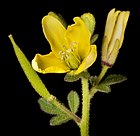Note: This is a project under development. The articles on this wiki are just being initiated and broadly incomplete. You can Help creating new pages.
Cleome viscosa - Tilaparni
Tilaparni is an erect, branched, annual plant with sticky leaves. It can grow 40 - 150cm tall. The plant is gathered from the wild for local use as a food and medicine. The plant is occasionally cultivated in India, where it is gaining in popularity as a low-cost substitute for cumin. Its cultivation is promoted for degraded or marginal agricultural land where it can be cultivated with less difficulty than traditional crops.
Contents
- 1 Uses
- 2 Parts Used
- 3 Chemical Composition
- 4 Common names
- 5 Properties
- 6 Habit
- 7 Identification
- 8 List of Ayurvedic medicine in which the herb is used
- 9 Where to get the saplings
- 10 Mode of Propagation
- 11 How to plant/cultivate
- 12 Commonly seen growing in areas
- 13 Photo Gallery
- 14 References
- 15 External Links
Uses
Ringworm, Flatulence, Dyspepsia, Bronchitis, Wounds, Inflammation [1]
Parts Used
Chemical Composition
Common names
| Language | Common name |
|---|---|
| Kannada | Antu saasive gida, Haladimaamballi, Kaadusassive, Naayi saasive, Nayibela |
| Hindi | Bagro, Hulhul, Hurhur, Jakhya |
| Malayalam | Aria-veela, Ariavila, Atunarivela, Katkudagu, Naivela |
| Tamil | Kaattu kadugu, Naai vealai elai, Nayikkadugu, Nayivelai, Peruvelai, |
| Telugu | Kukha-avalu, Kukhavavulu, Kukhavominta |
| Marathi | NA |
| Gujarathi | NA |
| Punjabi | NA |
| Kashmiri | NA |
| Sanskrit | Adityabhakta, Arikahita, Arkabhakta, Arkakanta, Brahmasuvarchala, Hulahula, Tilaparni |
| English |
Properties
Reference: Dravya - Substance, Rasa - Taste, Guna - Qualities, Veerya - Potency, Vipaka - Post-digesion effect, Karma - Pharmacological activity, Prabhava - Therepeutics.
Dravya
Rasa
Guna
Veerya
Vipaka
Karma
Prabhava
Habit
Identification
Leaf
| Kind | Shape | Feature |
|---|---|---|
| Palmately compound | Alternate | Petioles – of lower leaves 2.5 – 5cm long, Upper leaves 0.4 – 3.8cm Leaflets – sub sessile, elliptic – oblong or obovate. |
Flower
| Type | Size | Color and composition | Stamen | More information |
|---|---|---|---|---|
| Bisexual | Axillary lax raceme | Yellow | 12 - 18 | Flowers 1-1.5 cm across; pedicels to 1 cm long, elongate during fruiting. Sepals 4, 4-8 x 2-3 mm, lanceolate, apex acute, glandular hairy without. |
Fruit
| Type | Size | Mass | Appearance | Seeds | More information |
|---|---|---|---|---|---|
| A capsule | 5-6.5 x 0.3-0.5 cm | Linear-oblong, terete, striate, densely glandular hairy | seeds many, 1-1.5 mm across, reniform, transversely ridged, reddish-brown. | {{{6}}} |
Other features
List of Ayurvedic medicine in which the herb is used
Where to get the saplings
Mode of Propagation
How to plant/cultivate
Must be sown in sandy, well draining soil and only lightly covered. Requires bright and warm conditions to thrive. [4]
Commonly seen growing in areas
Tropical area, Sub tropical area
Photo Gallery
References
External Links
- Ayurvedic Herbs known to be helpful to treat Ringworm
- Ayurvedic Herbs known to be helpful to treat Flatulence
- Ayurvedic Herbs known to be helpful to treat Dyspepsia
- Ayurvedic Herbs known to be helpful to treat Bronchitis
- Ayurvedic Herbs known to be helpful to treat Wounds
- Ayurvedic Herbs known to be helpful to treat Inflammation
- Herbs with Whole plant used in medicine
- Herbs with common name in Kannada
- Herbs with common name in Hindi
- Herbs with common name in Malayalam
- Herbs with common name in Tamil
- Herbs with common name in Telugu
- Herbs with common name in Sanskrit
- Habit - Herb
- Index of Plants which can be propagated by Seeds
- Herbs that are commonly seen in the region of Tropical area
- Herbs that are commonly seen in the region of Sub tropical area
- Herbs
- Herb
- Cleomaceae






